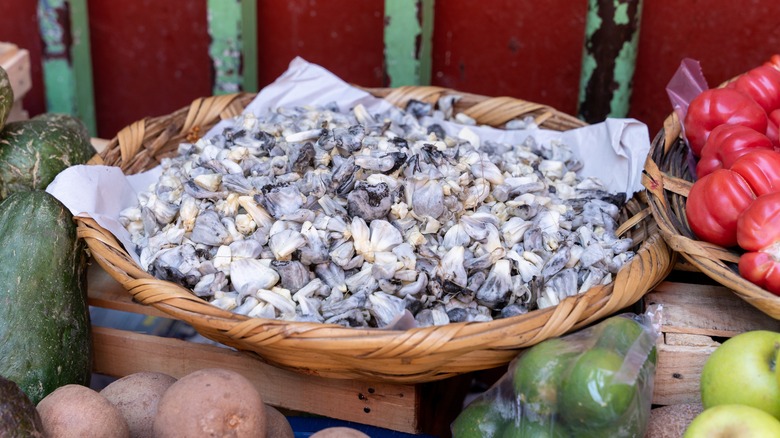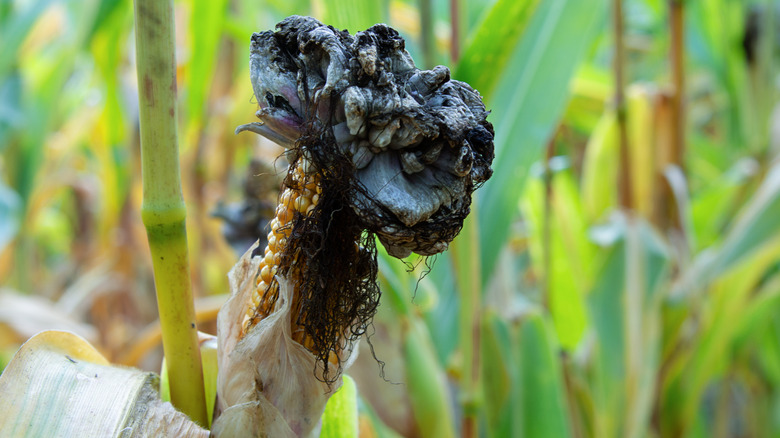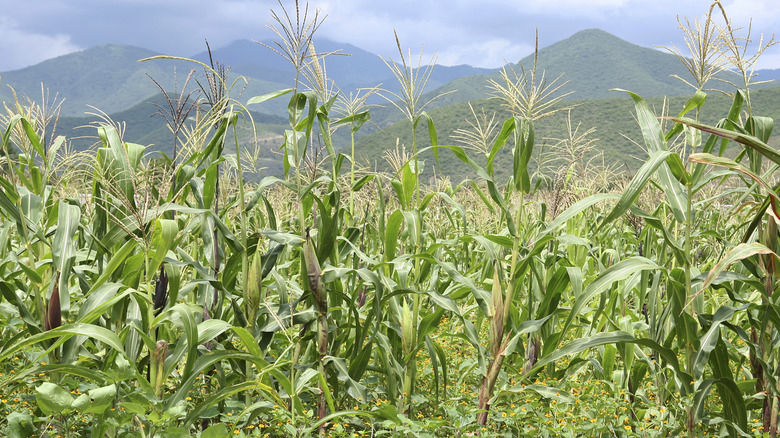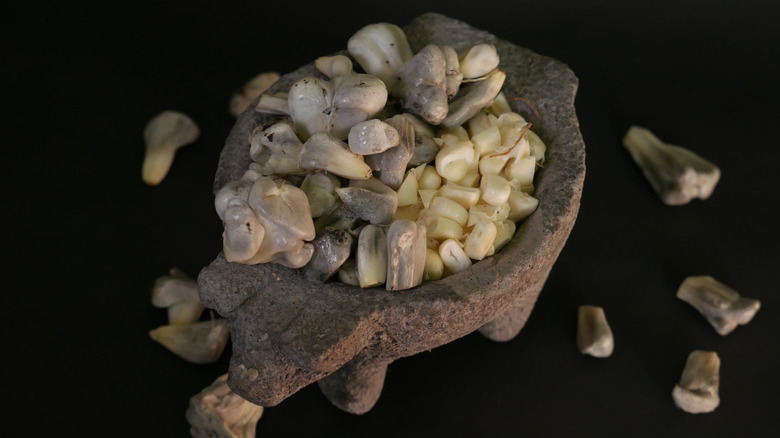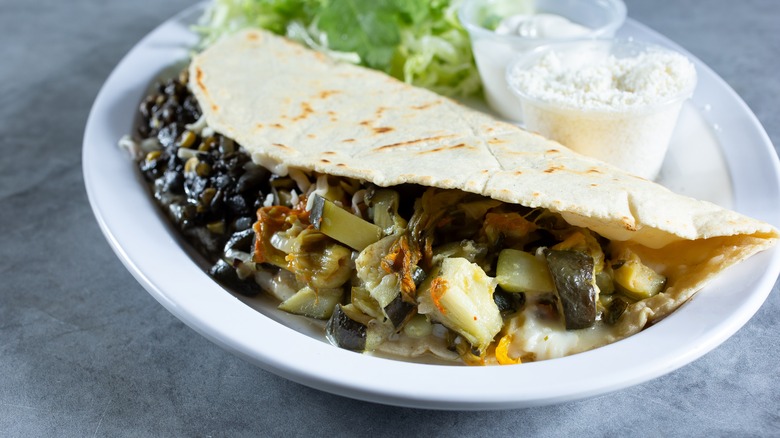What Is Huitlacoche And How Do You Cook It?
Corn smut, fungus, Mexican truffle, or Mexican caviar — these are just a few aliases of huitlacoche. But what exactly is this soft, spreadable, dark-as-night ingredient? In simple terms, it's a parasitic plant disease that grows on ears of corn, around the kernels, in puffy gray clouds resembling river stones. However, when this fungus enters the culinary world, huitlacoche becomes a delicacy featured prominently in some regional cuisines of Mexico.
Huitlacoche quesadillas and tamales are traditional favorites in Mexico. Perhaps unsurprisingly, given its origins, huitlacoche pairs naturally with corn tortillas. It also shines deliciously as a filling for beef, chicken, pork, and seafood options like fish and scallops. It lends its distinctively earthy aroma and exquisite truffle-like flavor to many soups and sauces, including in its dehydrated form in the Tlaxcalan specialty, mole prieto.
Huitlacoche is also prized for its nutritional qualities; it's rich in dietary fiber, and contains almost all essential amino acids. It is also rich in B complex vitamins and minerals such as magnesium and phosphorus.
Where huitlacoche comes from
The name huitlacoche is derived from Nahuatl, the language of the Aztecs, which is still spoken by more than a million people in Mexico today. The use of this ingredient also dates back to this time. Corn, or maize, was a staple in the Aztecs' diet, and they primarily used the corn fungus in tamales and stews.
The Native American Hopi and Zuni tribes also worked with huitlacoche from the outset. The former called the fungus "nanha," while the latter held the ingredient in such high regard that they believed it symbolized the generation of life. In fact, huitlacoche has been an important food for the indigenous peoples of the Southwest for centuries, serving ceremonial, culinary, and medicinal purposes.
Of course, not everyone is comfortable with plant-ruining diseases affecting their crops. Many farmers outside of Mexico destroy infected plants, and new strains of corn have been developed that are resistant to the fungus. Fortunately, with the rise of culinary awareness, huitlacoche has become somewhat of a delicacy in the United States. For example, Josefina Howard, founder and the first chef-owner of Rosa Mexicano in New York, hosted a huitlacoche-focused dinner at the James Beard House in 1989. The dinner was so well-received that it inspired others to consider the ingredient. It is still served at Rosa Mexicano restaurants, as well as many other establishments, primarily Mexican ones.
When and where huitlacoche is harvested
As one might suspect, huitlacoche harvests coincide with the corn season in Mexico. However, instead of harvesting it when the ears of corn are ripe and ready, it is gathered whenever it appears, which typically occurs during the rainy months. This gives the fungus a specific window of seasonality, peaking between July and September. Nonetheless, certain weather factors, in addition to rain, are necessary for huitlacoche to thrive. For instance, the temperature and humidity must be within specific ranges (68 to 86 degrees Fahrenheit for temperature, and 77% to 80% for humidity).
Native varieties of corn are more susceptible to the fungus than modern hybrids, and also yield a greater harvest for culinary purposes (an estimated 20% to 30% more, in fact). Central Mexico is regarded as the primary growing region for huitlacoche, and this is also the region where the delicacy is traditionally consumed.
What to look for when buying huitlacoche
Huitlacoche is available at some Mexican food specialty stores and comes frozen, jarred, or canned. Since there's no need to strip the corn of the fungus, using huitlacoche in this form is quite easy, and requires little to no preparation.
If you do find it fresh, choose spores that are light gray in color on the outside, and have a spongy texture; firm ones are overripe and bitter. For a superior earthy-corn taste, opt for huitlacoche that forms on the ears, not the stalk. Occasionally, you may find this ideal huitlacoche at a farmers' market or a Mexican grocery.
Fresh huitlacoche can be stored in the refrigerator in the same way as mushrooms. However, it doesn't have a long shelf life, so if you get it right from the ear, use it as soon as possible. Canned, frozen, and jarred huitlacoche obviously last longer; once you open a can or jar, you can keep it in the fridge and use it for weeks.
How to prepare huitlacoche
Using huitlacoche in the kitchen is much easier than you might think. You can use it raw, and since it's a soft fungus, there's no need to chop, puree, or shred it — especially if you get it canned or frozen. If you manage to source fresh huitlacoche, you can add it whole to dishes or gently tear it apart with your fingers. Don't be surprised when the gray fungus turns black upon heating — this is a signature characteristic of the ingredient, and explains why many dishes containing huitlacoche have a dark hue.
Moreover, the ingredient pairs well with so many different dishes, you'll have no trouble finding ways to use it. Mexican recipes for soups, quesadillas, tacos, tamales, and crepes are all excellent options, but don't be afraid to experiment even further. In a way, you can think of pairing huitlacoche with items that you would normally add mushrooms to, and beyond.

